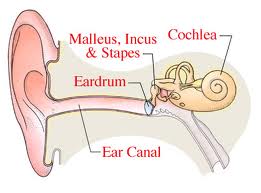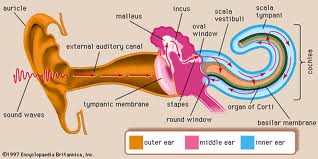|
What happens when the cochlea is damaged?
The CochleaThe cochlea is the main reason that we can hear and the majority of hearing losses in the world are due to damage caused to the cochlea,(sensori-neural). In nearly all cases the patient will struggle with speech discrimination ( “I can hear your voice but you sound like you are muttering”)This is made even worse in the presence of background noise. The fitting of hearing aids will be beneficial, but simply amplifying sounds will not overcome the problems found in the cochlea. We will now look at the various problems within the cochlea. I am talking here about the various intensities and frequency characteristics of speech. Most people with a cochlea loss will have better hearing in the low frequencies and poor hearing in the high frequencies.So, VOWELS are low frequency and can be heard, CONSANANTS are high frequency are less well heard, Consanants are also quieter than vowels, which increases the difficulties. Background noise is predominately low frequency, which also increases the chances of the quieter, high frequency consonants not being heard by the listener. Nearly all hearing instruments provide greater amplification to high frequency to help the situation. There are also ways of reducing the low frequency performance of a hearing aid ( a vent is a small channel in the earpiece which allows low frequency sound to escape out of the ear)
Loudness RecruitmentPeople with cochlea damage need a greater level of sound to hear well, but when sounds get louder they become just as intolerant of loud sounds as people with no hearing impairment. As seen in audiometry, this leaves the patient with a reduced dynamic range. This causes problems with speech discrimination, as the dynamic range of speech is about 50dB i.e. a 50dB intensity difference between the loudest and quietest parts of speech. Someone with a reduced dynamic range may not be able to accommodate the whole range of speech, which could become a problem when a hearing aid is fitted. A hearing instrument with the ability to adjust the amounts of amplification will provide a better option for patients with a reduced dynamic range.Recruitment is found only in patients with cochlea (hair cell) damage. The term “abnormal growth of loudness” is commonly used and relates to patients perception of loudness throughout their dynamic range. Frequency ResolutionThis is the ability of the ear to differentiate between sounds of similar frequencies. Frequency selectivity is very important when dealing with complex sounds, such as speech. A normal hearing ear has the ability to distinguish various frequencies with exceptional accuracy. However when hair cell become damaged this selectivity/resolution becomes less efficient and we then find it difficult to understand what is being said. The active mechanism in this process is the OHC and thus damage to these cells will lead to discrimination problems. Damage to IHC will reduce the sound getting to the brain and thus increased sound levels are required to overcome the damage. However complete damage of IHC would lead to Dead Regions i.e. a region of hair cells on the basilar membrane no longer working. This is difficult to identify from audiometry as nearby working hair cells will respond to sound of other frequencies. As yet there is no simple clinical procedure for determining the extent of dead regions.
Temporal ResolutionThis is the ability of the ear to detect changes over time; this involves detecting a short break in a sound, a short sound or a short change in sound. This is imperative for speech discrimination, it stops a voice being one long slur of noise! We also use this to differentiate between speech and background noise. If the intensity and frequency of a sound remains constant, the sound is said to be steady, e.g. a musical note. Noise is also heard as a steady sound even though its waveform is not regular but fluctuates rapidly. However speech is made up of audible gaps and the brain uses this information to hear speech even in the presence of background noise. A damaged hearing nerve loses its temporal resolution abilities and thus people perceive voices to be slurred or struggle with conversations in background noise. Temporal resolution is not purely a coch.le.a phenomenon; the nerve pathway and the brain are involved in the process. Neural or central (brain) disorders can also lead to speech discrimination problems but they are more associated with temporal resolution loss. Diplacusis*Patients with unilateral or asymmetrical hearing loss can perceive a single tone differently in each ear. (Diplacusis binauralis) *Sometimes found in symmetricial hearing losses. *Can be found in one ear and may be perceived as roughness/impurity to a specific tone or the tone has an additional undertone.(Diplacusic monauralis) *Causes speech discrimination, which is not easily rectified by the fitting of a hearing aid. ParacucisAlthough not a cochlea disorder, paracusis is a conductive phenomenon, wherby a patient is able to hear well in the presence of background noise. Patients with conductive losses have good cochlea function but reduced hearing threshold. With most speaking voices they hear them quieter in normal listening situations. However in noisy situations the speaker themselves will raise their voices over the background noise. Hyperacusis*An intolerance to normal environmental sounds. *Discomfort from sounds that previously were not comfortable or which other people do not find comfortable. *Oversensitivity to any sound. * unlike recruitment, the patient doesn’t have abnormal growth of loudness(even if their dynamic range is reduced, (unless it is due to hair cell damage) *Usually found in cochlea disorders and patients with tinnitus. *Can be a symptom of noise trauma. *Hyperacusis has been reported in patients with normal hearing.
|








